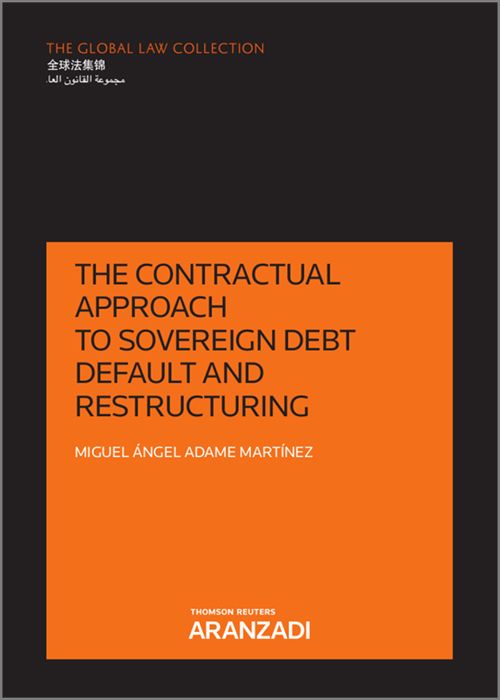The contractual approach to sovereign debt default and restructuring
- ISBN: 9788413919515
- Editorial: Editorial Aranzadi
- Fecha de la edición: 2022
- Lugar de la edición: Pamplona. España
- Colección: The Global Law Collection
- Encuadernación: Rústica
- Medidas: 24 cm
- Nº Pág.: 663
- Idiomas: Inglés

Servicio de búsqueda de libros
Este libro está agotado o descatalogado por la editorial. Si lo desea podemos buscar esta obra en librerías de saldo y ocasión.
Sí, por favor búsquenme este libroThe book defends a contractual approach to Sovereign debt default and restructuring as the best option to handle the crisis. It rejects the majority trend aiming at a public law approach to default and restructuring in the form of a bankruptcy procedure.
It offers a critical analysis of the current status quo in Sovereign debt.
It gives a practical approach to Sovereign debt default and restructuring.
It also test the proposed solutions against the newest methodologies.
Sovereign Debt (SD) is a subject of pervasive interests considering its size and that keeps on growing unabated. The book defends a contractual approach to manage SD default and restructuring against a trend fostered by international organizations and groups of interests that are trying to introduce a public solution akind to a bankruptcy procedure for the embattled Sovereigns. It carefully debunks the arguments of those that defend the bankrucpty approach, and shows with a palette of arguments that the contractual approach streamlined with new clauses and incorporating some elements from the ongoing reform of the international financial architecture is the best alternative to handle it efficiently. Contract law, enhanced via the newly generated transnational private law on the field --that becames a sort of lex mercatoria debitoris soberanis--, is analyzed and applied. Solutions are tested and confirmed against the leading methodological approaches, L&E, game theory and a touch of the critique.
Although the book is writen from a technical legal perspective it frames the legal solutions within the economic and political background, as SD is at the core of both the monetary system and the payment systems.
CHAPTER I
THE CURRENT MACROECONOMIC BACKGROUND
1.1.A world in debt
1.2.Why debt has been incurred
1.3.Is debt a bad or a good thing?
1.4.Sovereign Debt in the view of leading economists and schools
1.4.1.Adam Smith
1.4.2.Karl Marx
1.4.3.Thomas Piketty
1.4.4.John Maynard Keynes
1.4.5.Friedrich A. Hayek
1.4.6.Marriner Eccles
1.4.7.Irvin Fisher
1.4.8.Abba Ptachya Lerner
1.4.9.Modern monetary theory
1.4.10.Some reactions form the orthodoxy
1.5.Dealing with Sovereign Debt: the unconventional monetary policies
1.6.The consequences of resorting to unconventional monetary policies
1.7.The way out of unconventional monetary policies
CHAPTER 2
THE CONSTITUENTS OF SOVEREIGN DEBT/SOVEREIGN DEBT IN A CONTEXT. THE PREFERENCE FOR THE CONTRACTUAL APPROACH
2.1.Mapping of sovereign debt
2.2.Sovereign Debt and the political constraints
2.3.The balance between the Sovereign and the creditors
2.4.The current Sovereign Debt scenario
2.4.1.Introduction
2.4.2.The noisy litigation
2.4.2.1.Argentina
2.4.2.2.Greece
2.4.2.3.Ukraine
2.4.2.4.Bank crises in Iceland and Cyprus
2.4.2.5.The challenge to Sovereign Debt bonds purchased by the ECB
2.4.2.6.Sovereign Debt litigation in front of the ICSID and the ECHR
2.4.3.Holdouts, the problem that wasn’t
2.4.4.The actual situation regarding sovereign debt
2.5.The public approach to Sovereign Debt default and restructuring
2.5.1.The different positions
2.5.2.A critical view of the public approach to Sovereign Default and restructuring
2.5.2.1.General criticism
2.5.2.2.The inadequacy of the us bankruptcy code as a model for Sovereign Debt default and restructuring
2.6.A preliminary methodological approach to contracts
2.6.1.General background
2.6.2.Its application to the SD domain. Rules vs standards. The SD bond as a contractual right, not property right (investment)
2.6.3.Toward a contractual approach to bankruptcy
2.6.4.Game theory as a useful tool to analyze Sovereign Debt negotiation
2.6.4.1.Introduction
2.6.4.2.Game theory analysis and Sovereign Debt
2.7.The ongoing reform of the international financial architecture
2.7.1.The main lines of the reform
2.7.2.The basel framework and the treatment of Sovereign Debt
2.7.3.The debate over the reform of the current regulatory treatment of SD in the basel framework
2.7.4.The role of Sovereign Debt in derivative markets and repo markets
CHAPTER 3
THE CONTRACTUAL APPROACH TO SOVEREIGN DEBT DEFAULT AND RESTRUCTURING
3.1.A contracts approach to sovereign debt. Introduction
3.2.The merits of private law and its application
3.3.Contract law
3.3.1.Contract law as default regulation for Sovereign Debt
3.3.1.1.Contract formation and essentialia negotii
3.3.1.2.Contractual information
3.3.1.3.Accountability
3.3.1.4.Privity of contract
3.3.1.5.Breach of contract
3.3.1.6.Impossibility, commercial impracticability or frustration of purpose
3.4.The transnational private law approach to sovereign debt default and restructuring
3.4.1.Transnational private law as a tool to enhance the contractual approach to Sovereign Debt
3.4.2.The lex mercatoria debitoris soberanis
3.4.3.Collective action clauses
3.4.4.The application to unconscionability and transparency
3.4.5.Restitution as a right to the creditor
3.4.6.Mimicking a collective proceeding. Cross-default clauses. Cross-acceleration clauses. Stay of proceedings and engagement clauses
3.4.7.Necessity
3.4.8.Litigation based upon discrimination among Sovereign Debt bondholders and the role of pari passu. Mimicking creditor’s protection
3.4.9.Privileges, credit preferences and guarantees. The negative pledge clause
3.4.10.Reprofiling and restructuring as two significant applications of contract law
3.4.11.Gratuitous termination of debt and debt jubilee
3.4.11.1.The Hamilton moment
3.4.11.2.Sovereign Debt cancellation and the jubilee
3.4.12.Transnational private law, Sovereign Debt and human rights
3.4.13.Transnational private law and the domestic forum
3.5.The protection of the Sovereign
3.5.1.The protection via Sovereign immunities
3.5.2.Non-assignability of Sovereign Debt bonds
3.5.3.The Sovereign and the theory of the commons
3.5.4.The Sovereign and the macro prudential policies (mpp). Reform of the international financial architecture. International financial standards
3.5.5.The application of the macro prudential policies to the Sovereign. The Sovereign as a g-sifi
3.6.The master of ceremonies
SELECTED BIBLIOGRAPHY










